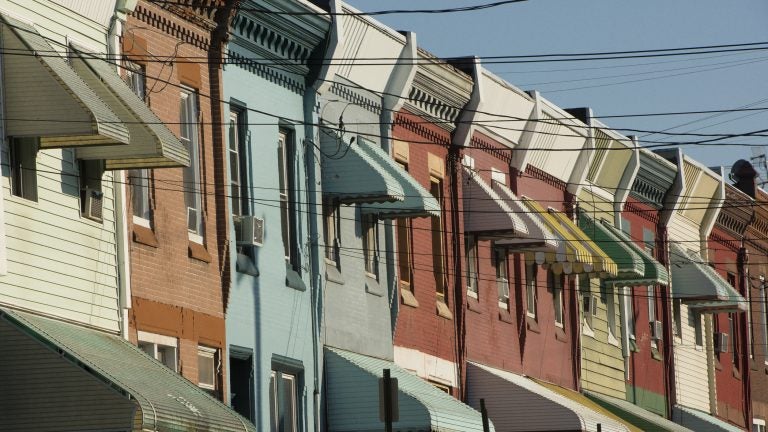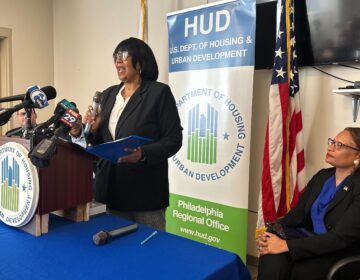Study: 41% of Philly area renters live in houses that need repair
A new study from the Philadelphia Federal Reserve finds major home repair needs in the region with impacts particularly significant for low-income renters.

North 29th Street (Jonathan Wilson for WHYY)
Our homes in the Philadelphia region are aging. Many of us live in dwellings built at least 50, if not 100, years ago. That means both homeowners and renters of limited means may struggle to access safe, healthy and physically adequate housing. And while the Philadelphia area boasts a high homeownership rate among low-income households, renting remains the only feasible option for many. For these renters, the challenge of finding adequate housing is fundamentally connected to the more widely discussed affordable housing shortage.
The Philadelphia Fed’s latest estimates show there were just 30 affordable and available units for every 100 extremely low-income renter households in the region in 2016. That means that over two-thirds of these households had no alternative to living in housing where they struggled to cover the rent, much less have the means to move to a higher quality unit. Given the growing scarcity of low-cost rental units in the Philadelphia area, particularly within the city itself, it is not surprising that our data show renters are more likely to live in lower quality housing, which can present significant hazards to residents’ health and well-being.
New Research Exposes Inequities
The Philadelphia Fed and PolicyMap partnered to estimate the costs of needed housing repairs. Combining data on deficiencies from the nationally-representative American Housing Survey with industry-standard repair cost estimates, we calculated the costs of repairs — ranging from modest maintenance issues, such as peeling or chipping paint, to major deficiencies in key building systems such as roofs, heating equipment, and exterior walls — for the nation and for individual metropolitan areas. We estimated that in 2018, the bill to repair all occupied housing units in the Philadelphia metro area was over $2.7 billion, with rental units alone totaling over $900 million.
Locally, 41% of renter households reported at least one repair need, but this figure masks substantive disparities in access to adequate-quality housing. Across renters and homeowners, roughly half of Black and Hispanic households reported repair needs, compared to about one-third of non-Hispanic White households. The poorest households were the most exposed to substandard conditions: Over 55% of the region’s households with incomes below the federal poverty line lived in units in some level of disrepair. Over 60% of low-income renter households with repair needs were headed by single women, and just under 45% were households with children, who are thought to be more vulnerable to the negative physical and mental health effects of substandard housing.
Unintended Consequences
Creating appropriate policies to address the rental repair issue requires that we consider not only the reasons for underinvestment in the rental stock but also the potential unintended consequences of different approaches to improving housing quality. For example, is underinvestment the result of a strategic choice by sophisticated property investors attempting to maximize profit or a reflection of the economic realities of the low-cost rental market? Recent work from Evicted author Matthew Desmond and MIT sociologist Nathan Wilmers suggests that property owners in distressed neighborhoods may be able to extract outsized profits from low-income renters relative to investors in middle and upper-income areas. In contrast, prior work from sociologists Philip Garboden and Sandra Newman that examined the low-cost, small-scale (one to four unit) rental stock suggested that the majority of these units were either financially unsalvageable or close to it, in which case landlords may find it economically infeasible to invest in addressing substandard conditions.
A related question is whether the problem lies primarily with so-called “mom-and-pop” landlords looking to supplement their income with modest rental revenue, or with the large, Wall Street-affiliated investment firms that have emerged in the post-recession rental market. The Philadelphia region’s predominantly single-family rental stock (disproportionately made up of row houses) has historically been thought of as the domain of mom-and-pop landlords, some of whom could have difficulty financing necessary repairs to their rental units. However, the growing presence of institutional investors in the single-family rental market is well-documented in many other major metros. In hotter housing markets, large scale investors have used their ample access to financing to fund physical improvements, but often with the aim of reorienting the units toward a more affluent clientele, exacerbating the dearth of options available to low-income renters.
Clarifying these underlying dynamics is critical for understanding the potential unintended consequences of different policy responses. In what situations would improving the rental housing stock through stepped-up code enforcement destabilize existing tenants and cause an increase in rents? In what contexts would financially assisting cash-strapped landlords with repairs accelerate the up-marketing of previously low-cost units? As local officials begin to grapple with this issue, we must answer these questions in order to make equitable progress on one of the region’s most intractable housing issues.
Eileen Divringi is a Community Development Research Associate at the Federal Reserve Bank of Philadelphia. The views reflected in this article represent those of the author and not necessarily those of the Philadelphia Fed or the Federal Reserve System.
Eliza Wallace is the Data Development Lead at PolicyMap. The views reflected in this article represent those of the author and not necessarily those of PolicyMap, Inc.
WHYY is your source for fact-based, in-depth journalism and information. As a nonprofit organization, we rely on financial support from readers like you. Please give today.







